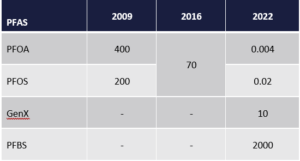The U.S. EPA (EPA) is following through on its PFAS Strategic Roadmap commitments to regulate PFAS and to integrate PFAS as contaminants to be addressed in the normal course of environmental work. Proposed Maximum Contaminant Levels (MCLs) are imminent, and will likely be influenced by Health Advisory Levels (HALs) issued late in the spring. MCLs will not likely be as low as the HALs, but could be set at reliably achievable detection limits. The HALs fulfilled the Roadmap commitment for PFBS and GenX, but EPA went a step further and chose to revise its HALs for PFOA and PFOS. The provisional HALs issued in 2009 for PFOA and PFOS have been reduced by factors of 100,000 and 10,000, respectively, to part-per-quadrillion (ppq) levels that cannot yet be measured by commercial laboratories.
U.S. EPA Health Advisory Levels for PFAS, in units of ng/L = parts-per-trillion (ppt)

Before delving into the details of the PFOA and PFOS HALs, the significance of the GenX and PFBS HALs should not be overlooked. The 10 ppt HAL for GenX – seven times lower than EPA’s previous HAL for PFOA/PFOS – is noteworthy given that GenX is a short-chain, replacement PFAS that is still widely used in commerce. Chemours has petitioned to challenge this HAL, which was issued without the opportunity for public comment. The 2,000 ppt HAL for PFBS (another short-chain compound) may appear of lesser significance relative to other PFAS, but numerically is lower than or equal to the Maximum Contaminant Levels (MCLs) for a number of contaminants including arsenic, trichloroethylene, benzene, and vinyl chloride. Collectively, the new HALs for GenX and PFBS indicate a potential change in USEPA’s views on the toxicity of shortchain PFAS. Eventual regulation of short-chain PFAS is possible, and may be a relevant consideration in the design of treatment and remediation measures since most alternatives are less effective for short-chain compounds.
Returning to PFOA and PFOS, the multi-order of magnitude decreases in HALs have resulted from a toxicity basis shift to epidemiological evidence that indicates vaccines are less effective in infants exposed to higher levels of PFAS, as measured by lower tetanus (PFOA) and diphtheria (PFOS) antibody response in 5-year-olds. Although the underlying causal relationship is yet to be identified, the statistical associations suggest weakened immune system development at higher PFAS exposures. As these effects are observed at actual environmental exposure levels, PFAS exposures would need to be greatly reduced to protect public health. EPA’s HAL for PFOA is based on a target PFAS concentration in serum of 0.17 ppb in an infant, which is 1-2 orders of magnitude smaller than the levels of PFAS currently found in infants. Given that recent statistics regarding tetanus and diphtheria disease in the U.S. indicates very low incidence (on the order of a few hundred cases per year on average), does this imply that USEPA believes that PFAS may be affecting immune system development more generally for a number of diseases? It appears EPA may be considering using these data to establish MCLs that would be protective of potential immune deficiency in the general population based on the single study findings for tetanus and diphtheria. For more information on the scientific basis of the PFAS HALs, download Steve Zemba’s recent presentation given at the annual New England Water Works Association Conference.
Because the PFOA and PFOS HALs are well below detection limits of current analytical methods, EPA could propose its forthcoming MCLs at some reliable detection limit such as 4 ppt (based on recent FAQ discussion). However, even though not legally enforceable, the mere existence of ppq-level HALs signifies EPA appears to have concerns over PFAS health effects at levels well below drinking water standards that have been established in numerous states.
Another of EPA’s major announcements was the proposed designation of PFOA and PFOS as hazardous substances under the Comprehensive Environmental Response, Compensation and Liability Act (CERCLA). This long-anticipated action has far-reaching and significant implications that we will explore in our next blog installment.
Posted In: Articles
Tagged In: Industrial, PFAS, Research






